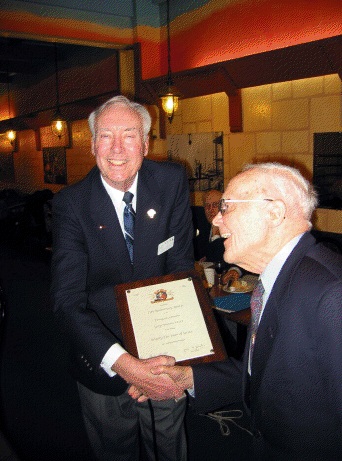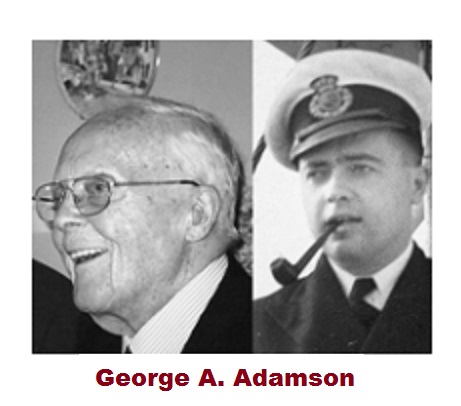
George
Adamson VE3XS (right) receiving his 75 year pin from
Doug Leach, VE3XK at QCWA 8 Mar, 2005
(John Gilbert, photo).
George passed away on March 24, 2010 in Ottawa. The following is an interview
with George by Ernie Brown, prepared May 1998 and reproduced here with Ernie’s
permission.
George was born in Darlington, England, on October 2, 1910. He lost the sight of
his right eye through an accident, with a sharp pencil, at the age of 4 years.
While in high school, he and a friend built radio broadcast receivers using
three tubes. He developed an interest in going to sea as a radio operator. After
High School he attended the Cardiff Radio School and in 1927 qualified for the
PMG 1st Class Radio Certificate. (Post Master General was the regulatory body
issuing the Radio Certificates.) He found there were no job openings at the
time, so spent two years driving trucks, delivering fertilizer to farmers, which
was his Father’s business. His Mother was corresponding with her brother in
Toronto, and he suggested there may be jobs available in Canada. As a result,
George took passage on the “Duchess of Richmond” to Canada in 1930. Third class
passengers had to disembark at Quebec City, so he had the long train ride to
Toronto. On arriving at Union Station in Toronto, he was met by his cousin, and
was impressed by the huge columns of the Union Station and the parade with bands
playing on the street to welcome him. He found that this was the 24th of May,
the Queen’s birthday celebration! He stayed at the home of his Uncle, Charlie
Brown, and visited Canada Steamship Lines office to see about a job. They
advised him they hired Radio Operators through Canadian Marconi Company, and in
their office he was interviewed by Mr. C. S. MacDonald. Mr. MacDonald said they
would call him at his Uncle’s home, where the phone number was Holland 1488. The
call came at the end of the week, and Mr. MacDonald delivered to him train
tickets to Fort William where he was to join the grain carrier “Gleneagles”. The
train left Toronto at midnight, and arrived at Fort William about 4PM He stayed
overnight at the King Edward Hotel, and next day went by taxi to the ship. He
remembers seeing Buffalo grazing in a field along the way.
The radio equipment on the “Gleneagles” was a 500W spark transmitter, with a
receiver having a crystal detector and two-tube amplifier, and powered by
batteries. On leaving the Port he fired up the transmitter to get a signal check
from Port Arthur radio, VBA, and found the equipment working well. The loaded
ship sailed to Port Colbourne. He spent nine years on the lakes, and was radio
operator aboard the passenger vessel ‘Harmonic” in the last few years of that
time. During the winter months when the ships were tied up, he stayed with
Walter Twomley in Toronto, and they built an amateur radio station, using a pair
of 45 tubes in a push-pull oscillator circuit. In the winter of 1932 George
obtained the amateur radio license, and the call sign VE3YA.
During his years on the Great Lakes he copied only two SOS calls. One in about
1934 was from the US Passenger ship “George M. Cox” which ran aground on the
western tip of Isle Royale in fog. The ship ran up on the shelving rock, and
passengers were able to walk off the ship without getting their feet wet. The
other was from an Algoma Central ship, which had collided in fog with another US
ship. Pat McMenemy was the operator on the Algoma Central ship.
In 1939 he had responded to an advertisement by the Government of Canada for
Radio Operators, and when the ship docked in Sarnia, there was a letter from the
Government waiting for him. He reported to the Meteorological Office in Toronto
for a two week course in weather observing. Then was posted to Killaloe Radio
Range. At Killaloe he was attracted to Marion, the daughter of another Radio
Operator on the station.
In 1940 he was transferred to St Hubert where they needed CW operators for the
Airlines operating position. The Dorval station was being built at the time, and
one day he finished the midnight shift at St Hubert, and reported on the next
shift to Dorval. In a year or so he was doing maintenance at the Beaconsfield
transmitter station, working 16 hour shifts at the site. Jim McKay from Ottawa
came to visit him there as he was looking for technicians to build Fan Marker
Monitoring receivers. George accepted the transfer as it would greatly shorten
the drive to Killaloe to visit Marion. He reported to Jack Brooman at the test
labs, but found himself building crates to ship equipment to the North West
Staging Route! (The NWSR was the chain of airfields through northern BC and the
Yukon and Alaska.)
George and Marion were married in 1942, and lived in rooms rented from Fred
Hatch on Clarendon Ave. The position of Officer in Charge at Earlton Radio Range
was advertised, and George applied and was selected. They were at Earlton from
1943 to 1947, when they came to Ottawa. Daughter Patricia, and son George, were
born while at Earlton, in the hospital at Haileybury. In September 1947, he was
appointed a Radio Technician at the Ottawa Short Wave Transmitter Station, on
Greenbank Road. Houses for staff were under construction, but not yet ready.
They stayed at Webb’s Motel on Carling Av. until their house was ready. He
worked the night shift at the station and his hours for sleeping did not match
those of daughter Patricia, nor of George. During their time at Greenbank Road,
Pamela and David were added to the family.
Bill Aitken was another Technician on the station and Ed Gauthier was Officer in
Charge. Mr. Gauthier became ill, was sent to the Hospital at Brockville, and did
not return. The new OIC appointed in 1949 was Bill Maclean from the west coast.
In 1954 Mr. Maclean moved to the USA to work for one of the electronics
companies, and George became the OIC. The station had 4 transmitters for the
Department of Transport, three for the Time Signal CHU, a number of VHF and UHF
transmitters for the Ottawa Aeradio Station, and one for the RCMP. There were 6
rhombic antennas (large, diamond shaped antennas, pointed in the direction of
the receiving stations) directed on six different locations, east west and
north. During these years George’s vision was gradually deteriorating. In 1962
when he could no longer drive the station vehicle, which was required of the
OIC, he was moved to the Clyde Av. Laboratory where he worked at calibrating
test instruments. They now had a home on Glenmount Av. He worked at Clyde Avenue
until retirement in 1974. George continues to enjoy amateur radio with the call
sign VE3XS, and sings with the CNIB choir.
(Prepared by E. Brown, May 1998)
|
|
 |
|
 |
|
 |
|
Obituary - Avis de décès
George A. Adamson
1910 - 2010 |
|

ADAMSON, George A. Silent Key VE3XS Peacefully at
home, surrounded by his family on Wednesday, March 24, 2010 in his 100th year.
Beloved husband of Marion (nee Herbert). Cherished father of
Patricia Drew (Bob), George (Sandra), Pamela Thornton and David (Cathy). Loving
grandfather of Joanne, Laura, Gregory, Michael, Geoffrey, Christopher, Andrew,
Scott, Jessie, John, Thomas and great-grandfather of Nicholas, Liam, Olivia,
Hannah, Katarina, Corynne, Elise and William. Dear brother of the late John
(Lilian).
Special thanks to the staff at the Ravines Retirement Home for
their care and kindness. Friends may call at the Westboro Chapel of Tubman
Funeral Homes, 403 Richmond Road (at Roosevelt) on Saturday, March 27, 2010 from
11 a.m. until time of memorial service in the chapel at 1 p.m.
In lieu of flowers, donations to the Palliative Care Outreach
Program, the CNIB or the charity of your choice would be appreciated.
|
|
Links - Liens
|
|

